Allô! 👋
Welcome (back) to good food at home, the monthly-ish newsletter featuring simple, seasonal, and sustainable meals, tips, and ideas. For more recipes, cooking Q&As + access to the full archive, consider joining the community of readers who support the newsletter by also subscribing to seasonal sundays, the supplement that focuses on fresh produce at its peak!
May is a marvellous month.
By five in the morning the sky is already bright, its light lingering long into the night, drawing the evenings out well beyond 9PM (the days, in fact, are so long that the sun rises and sets at nearly the same northerly point on the horizon). Days stretch luxuriously, warm enough at last to invite long, unhurried meals outdoors if the weather is dry. And, all around, people — young and old — seem reflexively preoccupied with flowers: planting them, picking them, arranging them, sniffing them, admiring them.
It is a glorious time to be out enjoying nature.
Farmers’ market enthusiasts will know firsthand that mid-to-late spring is a heavenly period: a short-lived season where pleasures such as ramsons/ramps and morels, elderflowers and fiddleheads, wild asparagus and young nettle tops quickly come then go again in swift succession.
Happily, other seasonal joys tend to linger a little while longer (though even these are only at their peak for a brief window of time): crimson rhubarb, snappy stalks of white, purple, and green asparagus, fresh leafy radishes (the kind that aren’t nose-tinglingly peppery yet), tender spinach, pea shoots, and early snap peas. Young alliums and spring garlic. The year’s first strawberries. Perhaps even some early new potatoes and garden peas. Sorrel, bok choy, turnips, mizuna, lettuces, arugula. Spring artichokes and cabbages. Delicate fennel fronds, lovage leaves, chive blossoms, anise hyssop, and lemon balm. Foraged things. Fragrant things. Edible green tips and enticing burgeoning buds.
At once intensely ephemeral, and yet also a bolstering beginning to the increasing waves of bountiful harvests still to come.
Meanwhile, gardeners (and community-garden-frolickers like me) rejoiced this month at the sight of the year’s first fruits: currants, gooseberries, cherries, strawberries. For the most part, still hard, green, astringent, and not at all yet ripe — but growing ever larger and more promising with every passing day and night.
Across the city, aspen trees’ cotton-like pollen blows weightlessly, drifting softly through the streets like a gentle spring snow. The air is perfumed with lilac, honeysuckle, and elderflower, forming together an unmistakable cocktail of springtime fragrances.

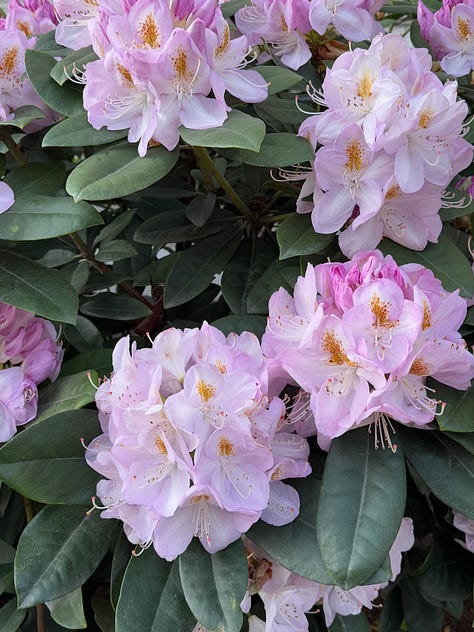

Indeed, anywhere you go, the sweet enticing sight and scent of flowers — lupins, hydrangeas, flowering black locust trees, mock-orange shrubs, cow parsley, hawthorn (AKA May blossom), lily of the valley, rhododendrons, wild roses, wintercress, peonies — beckon one’s senses to life. One could easily swoon from the sheer loveliness of it all.
In addition, since the month began, an ever-growing chorus of birdsong — and the occasional squirrel’s chatter — has weaved itself into the city’s soundscape, musically punctuating the soft, leafy hush of trees swaying in the rain or breeze during moments of relative quiet. Its unpolished permanence makes for a reassuring springtime symphony, if you care to lend an ear to it.
Be it with food or flora, in fragrance or fauna, this season’s earthly delights offer a blissful boon to the senses. All we have to do is pay attention, take a moment to notice, and make some time to take it all in.

Just as April was synonymous with all things young, tender, and green, May has come bursting forth with everything colourful, flowering, and soon-to-be-ripe.
Here in Oslo, it is (at least, in my opinion) the arrival of May that gets people to relax their winter shoulders and finally begin to feel that “summer” is here at last.

The days seem impossibly long already, yet the knowledge that they will only grow longer still, well into late June's summer solstice, is enough to make one giddy with glee.
This is the cherished in-between: not quite summer, but no longer early or mid-spring. A season in crescendo: welcome, late spring.

In this May issue of good food at home, in addition to a quick look at how I’ve been storing and enjoying a few seasonal favourites, you'll find some cooking inspiration from the newsletter and website, as well as a rough recipe for a rustic rhubarb galette, and a few parting links as food for thought. As always, I hope you’ll enjoy.
ㅤ
Wishing you all a splendid June ahead,
👋simoneㅤ
ㅤ
P.S. Like the newsletter? Leave it a ❤️ (or 🔄) to help it grow!
what to shop for & enjoy in late spring 🍓
You probably don’t need me to tell you that radishes, rhubarb, asparagus, strawberries, and spring garlic are all in season at the moment. That said, I hope you won’t mind me sharing my favourite ways to store and enjoy these springtime stalwarts as of late, in case you find it useful:
radishes
HOW I STORE THEM
Separate the leaves from the bulbs as soon as you get home; wash, then dry the greens as you would salad leaves or other spring greens, roughly chop or leave them whole, then store them fresh or frozen in an airtight container. Place the bulbs in their own airtight container and keep refrigerated, washing only when ready to use.
HOW I’VE BEEN ENJOYING THEM
The leaves are lovely barely wilted, as you might prepare spinach, and served with a fried egg and steam-sautéed asparagus (see below); as for the bulbs, lately I have been loving them simply raw, very thinly sliced, in herby green salads (like this one).
rhubarb
HOW I STORE IT
Place stems in a jar of water, as you would a bouquet of flowers, if planning on eating or cooking with them within a few days. Otherwise, cut into neat little cubes, tuck into an airtight container, then freeze for using in a crumble or stewing into a compote at a later date.
HOW I’VE BEEN ENJOYING IT
Thinly sliced and raw, swirled through thick, creamy yogurt along with fresh strawberries, chopped nuts, and last year’s honey.
asparagus
HOW I STORE IT
Place stalks in a narrow glass of water, then cover with a plastic bag or a tall wider glass to create a sort of miniature greenhouse environment; keep in the refrigerator door (or, at the very least, far from the back of the refrigerator where it is coldest) and plan to consume within five days.
HOW I’VE BEEN ENJOYING IT
Woody bottoms snapped off and composted, then stalky middles sliced into coins and tips left whole — steam-sautéed in a pan with a dash of sesame oil and a splash of water, just until vividly green but still crunchy, then served with salty sesame seeds and a fried runny-yolked egg.

strawberries
HOW I STORE THEM
If not eating immediately, place whole berries in an airtight container and keep, unwashed, in the refrigerator. Plan to wash then consume, cook, or freeze the berries within 3 days.
HOW I’VE BEEN ENJOYING THEM
Well-rinsed and raw, leafy tops on and all.
spring garlic
HOW I STORE IT
As with rhubarb, feel free to keep these in water like you would fresh-cut flowers. If kept alive like this long enough, the outer leaves will eventually yellow and wilt as the garlic bulb at the bottom grows larger and more potent.
HOW I’VE BEEN ENJOYING THEM
Grabbing only the top leaves so as to keep the bulbs alive, I’ve been using green garlic in cooked dishes anywhere I would otherwise have been happy to use green onions, tender green leek tops, or even mature cloves of garlic.
rhubarb & other late spring delights 🌸
Eating in spring truly is a beautiful thing. Radishes, rhubarb, wild garlic, fiddleheads, asparagus, young garlic, early strawberries — everything tastes of the fresh promise of something new.
Simple, seasonal, and sustainable is my motto for eating — and for living — and it’s how I like to prepare most things. One minor exception, or slight deviation, from this personal rule, however, seems to be with rhubarb: I really enjoy preparing it in ways that are slightly more elaborate than my usual (hence the many rhubarb recipes below).
Below are some of the latest and most seasonally-suited meals from the newsletter, Instagram, and the website (with only a modest emphasis on our flamboyant friend, the ruby-hued rhubarb):
Recipes marked with a 👋+ are for paid subscribers only, though each paid post contains a section available for all to read!
a celebratory spring bounty salad
For when you’re in the mood to showcase your fresh spring bounty all at one — with arugula (rocket), fennel, radishes, favas (broad beans), asparagus, mint leaves, and so much more.
ㅤ
a simply lovely rhubarb cake
Moist, fluffy, portable, shareable — the perfect bake for a late spring picnic with friends in the park.
ㅤ
spring blossom recipes
Some flowers are edible, some flowers are not! Find out all about how to use spring blossoms in the kitchen. Paid subscribers also get six methods for prolonging the fun, plus access to a more personal cooking Q&A.
ㅤ
asparagus & spiced eggs on toast
Springtime simplicity at is best, wonderful for an easy lunch, leisurely breakfast, or any other relaxed eating occasion.
ㅤㅤ
darling, you look radishing
Discover radishes in all their springtime glory! This post delves into radish varieties, uses, and how to store them. In addition, paid subscribers get 5 ways to prepare them, plus my best tips on reducing food waste.
ㅤ
...and more:
a multipurpose parmesan dressing
poached rhubarb & panna cotta 👋+
cool mint + pea soup
a light & flaky spring tart 👋+
mini rhubarb, strawberry & rose galettes
a rustic rhubarb galette 🍊
I have a particular fondness for fresh rhubarb. Raw, it is sharply sour and faintly astringent — though never unpleasantly so, if the stalks are properly ripe. There’s something oddly satisfying about that first bite: crisp, clean, and just this side of bracing.
It is when tasted like this, in its most natural state, stalk freshly torn from its cluster, that I find its custardy notes most salient. It goes without saying, then, that pairing rhubarb with some kind of custard (hot, cold, or even frozen, as in a yolk-rich ice cream) is almost always a very good idea indeed.
It’s also marvellous with orange zest (frozen or fresh; though, at this time of year, frozen is your better bet), cardamom, vanilla, ginger, and almonds.
Other good ways to savour rhubarb at the peak of its season include baking it into a crumble with strawberries, roasting it slowly in currant leaves, poaching it in citrusy spruce-tip syrup, fermenting it gently with elderflower into a fizzy brew, or simply stewing it softly in its own macerated juices.
If you’ve got too much fresh rhubarb on your hands this season, the easiest way to preserve it is quite simply to clean the stalks, chop them up, then freeze them — ready for when the urge for something tart, pink, and springlike returns later in the year.
If, on the other hand, you are already looking for a good Sunday bake, allow me then to tempt you with this rustic, rough, and rugged rhubarb, marmalade, and almond galette.
“Rustic, rough, and rugged”… you may think I’m only referring to the freehand tart pictured above, but these very same words could just as easily describe the recipe itself.
You see, this recipe isn’t really a ‘proper’ recipe to me, in that I have not yet had the chance to thoroughly test it. I’ve only made it once and jotted down ingredients, measurements, and steps as I went, vowing to return to them again at some later point, so as to ensure that my method is one that can yield reliably delicious results.
Trouble is, I’m still busy putting all my spare time and energy toward renovating my home (hence the recent pause on seasonal sundays issues) and don’t yet have a not-also-a-construction-site kitchen to work in… so, as much as I am dying to return to it, I haven’t yet been able to get back to recipe testing.
Still, the season for rhubarb is short. And I love this galette too much not to share it.
So I share it below with this caveat: the recipe is as rustic, rough, and rugged as the resulting tart itself. If you choose to follow it, know that it will probably work out just fine (it has after all worked marvellously well once already), but also that by choosing to try it, you are essentially agreeing to become part home cook, part recipe tester.
I do hope that seems as fair a compromise to you as it does to me.
RHUBARB, ALMOND & MARMALADE GALETTE WITH A RUSTIC OAT CRUST
makes approx. 12 servings
for the dough (make and chill in advance)
150g flour
75g ground rolled oats (alone or mixed with other rolled grains)*
½ tsp (2.5 mL) fine sea salt
140g cold unsalted butter
1 Tbsp (15mL) apple cider vinegar
~60g ice water
*I used rolled spelt that I pulsed to a flour using a food processor, but old-fashioned rolled grains of any kind (like barley, rye, wheat) could be used here, alone or together
note: if you like your crust a little sweet, feel free to add one tablespoon (12.5g) of sugar into the flour mix
Whisk the flour, ground oats, and salt together in a large bowl until evenly mixed.
Cut the butter into cubes and add the apple cider vinegar to the ice water.
Squish the butter into the flours, rubbing them between your fingers into floury butter tiles. Refrigerate briefly to harden the butter again if it has softened.
Sprinkle a few tablespoons of the iced vinegar water into the flours at a time, using a wooden spoon to mix and gather the ingredients, using only just enough liquid to achieve a crumbly dough that can be squeezed into holding itself together without falling apart.
Press the dough together into a scraggly ball, then flatten into a rough rectangle. Cover and chill for at least two hours (ideally overnight).
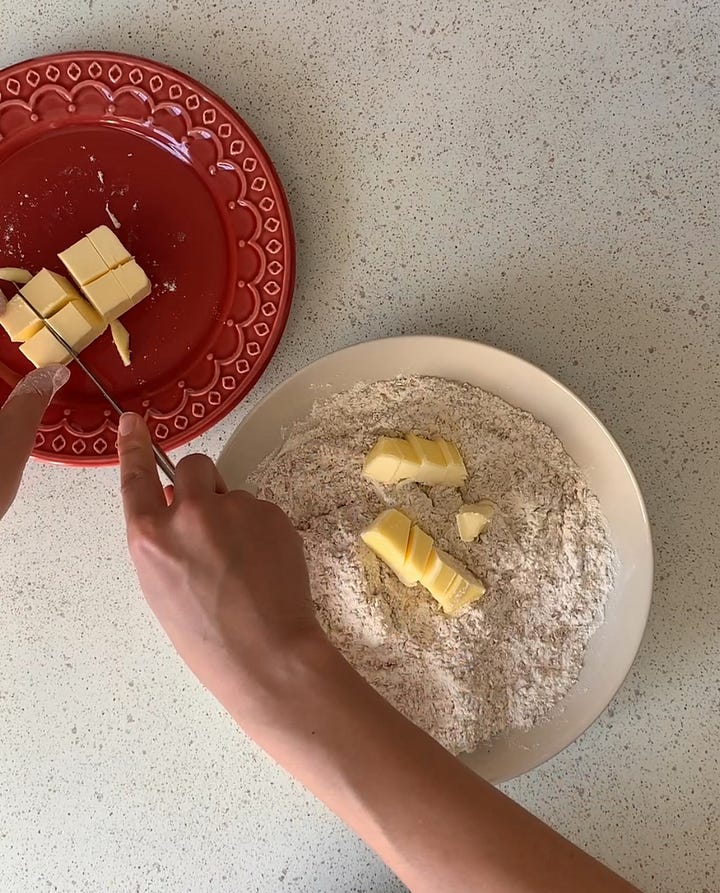
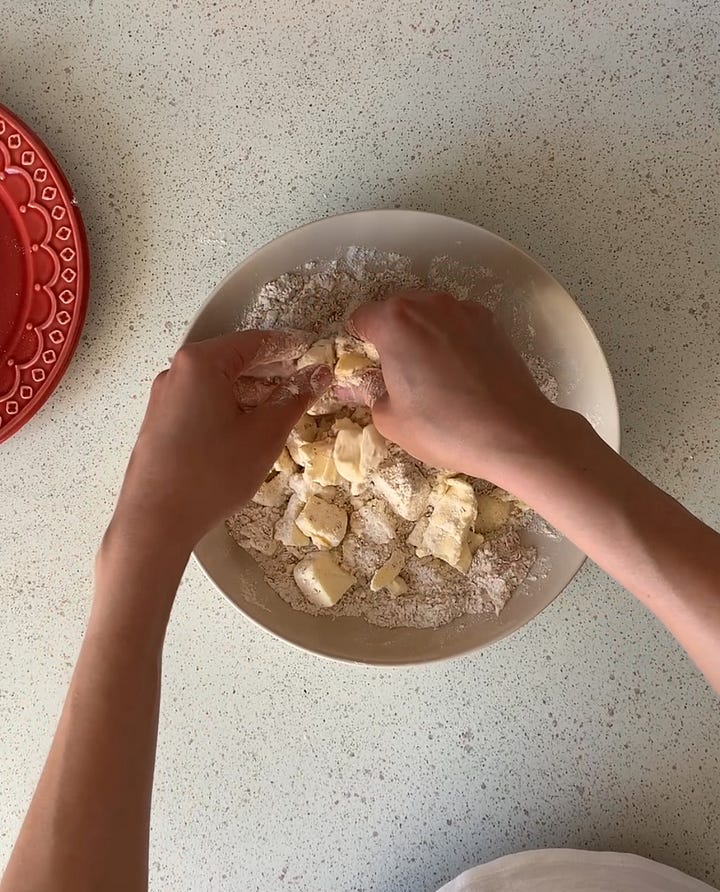
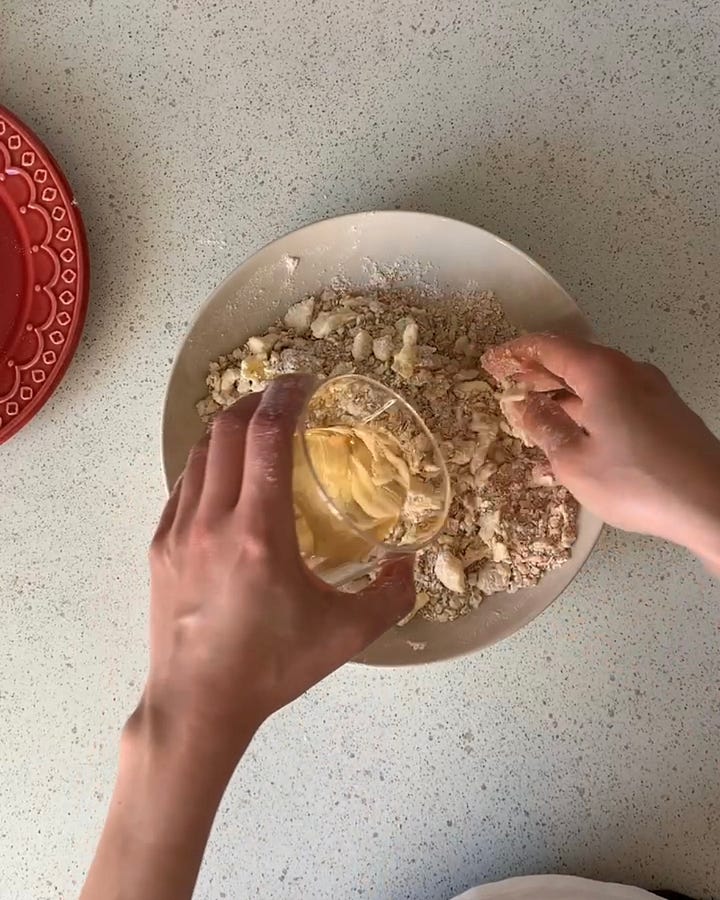

ㅤ
for the filling
~340g fresh rhubarb, cut into herringbones, or whichever size and shape you like
50g sugar
2 Tbsp flour
1 Tbsp orange zest (about the zest of 1 orange), fresh or frozen
the seeds of 1 vanilla bean / 1 scant tsp ground vanilla / 1 Tbsp vanilla extract or paste
a small pinch of fine sea salt
Once ready to assemble and bake the galette, combine all the filling ingredients together in a bowl and set aside.
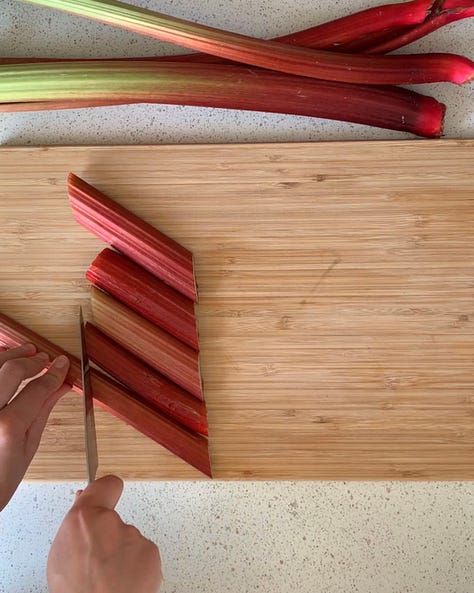
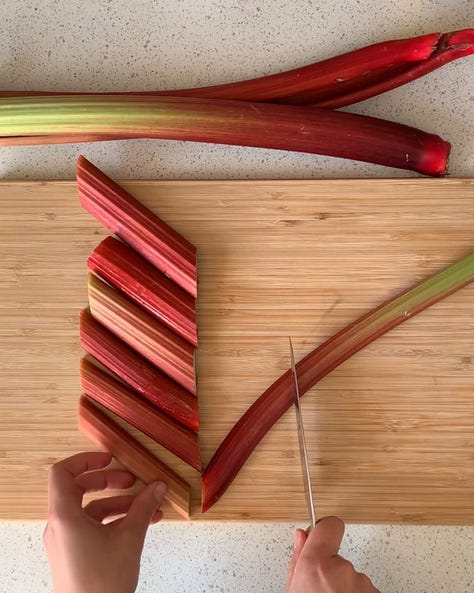

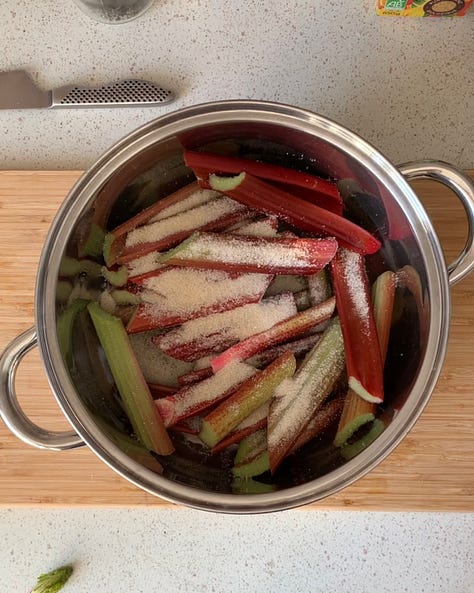
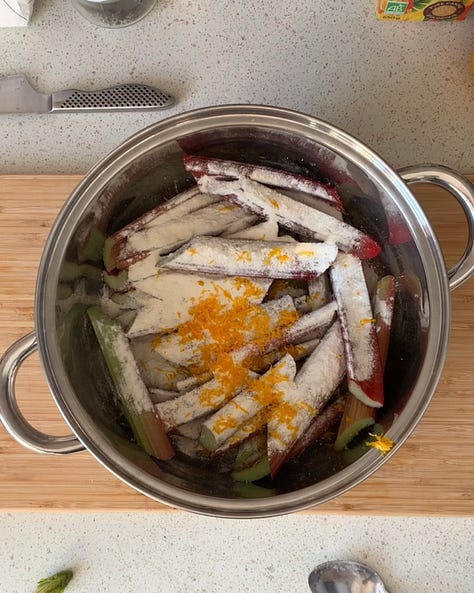
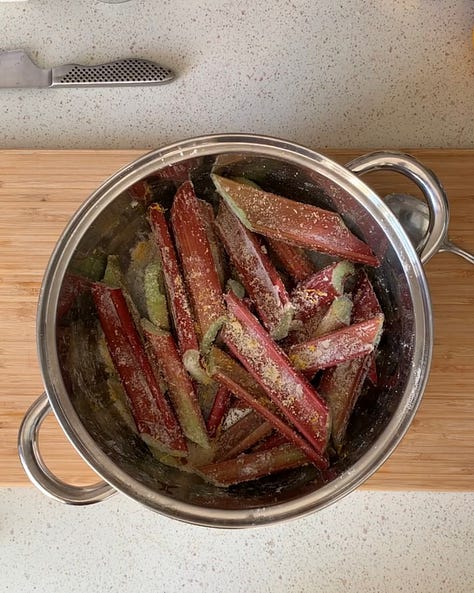
ㅤ
for the frangipane
75g sugar
75g unsalted butter, softened
½ tsp ground vanilla or ½ Tbsp vanilla extract or paste
1 scant tsp ground cardamom
½ tsp powdered ginger
150g coarse almond flour or ground almonds
2 eggs, at room temperature
Remove the chilled dough from the refrigerator so it becomes pliable enough to work with once you have made the frangipane.
Cream the sugar and butter together until fluffy using a spatula, then incorporate the vanilla, cardamom, and ginger into the mix.
Stir in the ground almonds in several additions.
Once well mixed and nicely fragrant, thoroughly whisk in the eggs. Set aside.
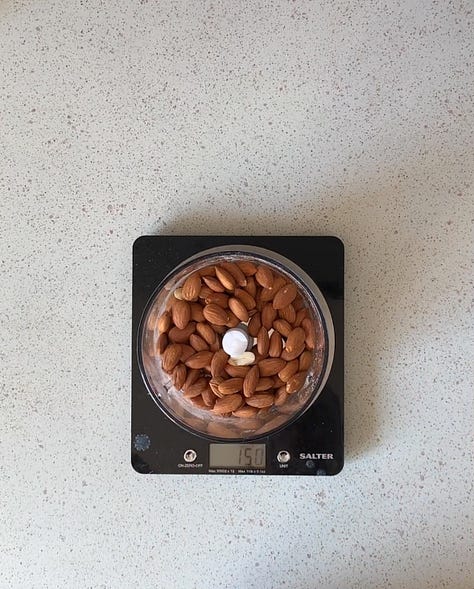
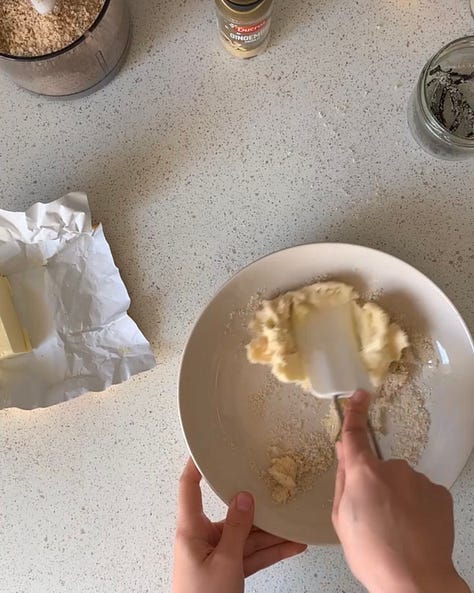
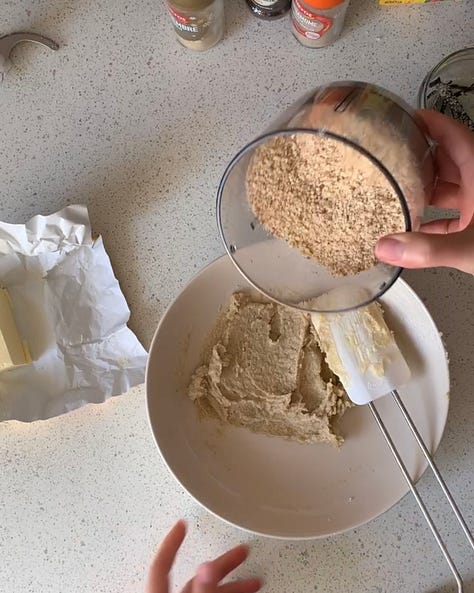
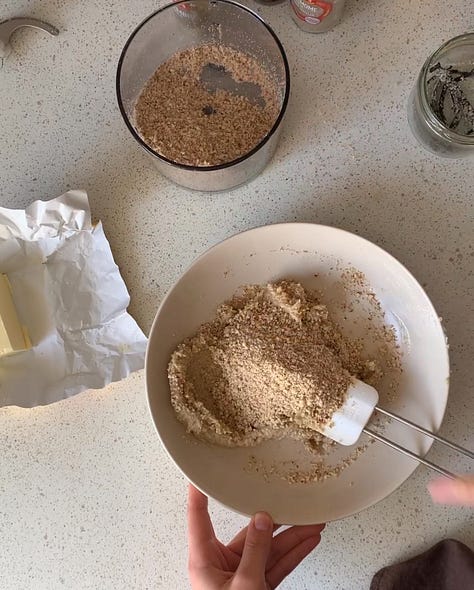
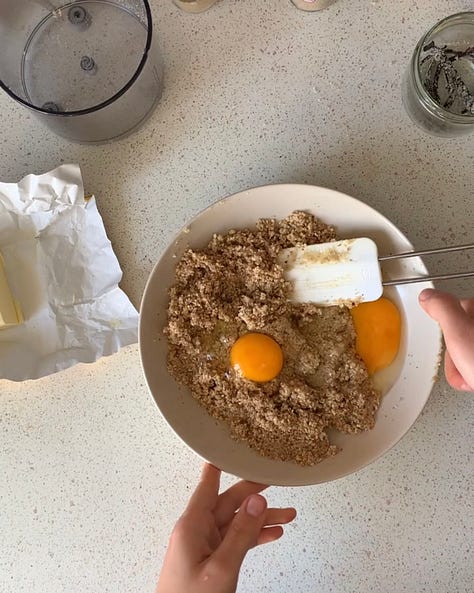
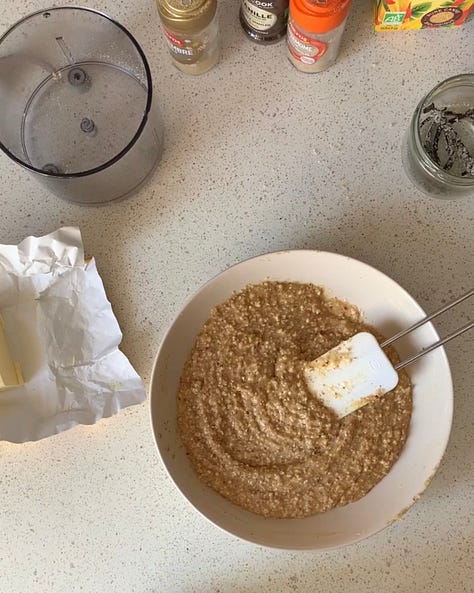
ㅤ
assembling the galette
the prepared dough
the prepared rhubarb filling
the prepared frangipane
~¼ cup marmalade† (about 4 heaping tsp)
1 egg
sugar, for sprinkling
a free shelf in your refrigerator, large enough to fit your chosen sheet pan / baking tray
†I like to use Wilkin & Sons ‘Tiptree’ orange marmalade, but feel free to choose whichever marmalade you enjoy most!
Roll the prepared dough out onto a sheet of parchment paper, until you get an evenly thin rectangle that is roughly 25 x 35cm in size (9.8 x 13.8"), and 5mm (⅛-¼") thick. Slide the parchment sheet with the dough onto a sheet pan or baking tray for ease of transfer later.
Leaving a border of roughly 5cm all around, smear a rectangle of marmalade out onto the rolled-out rectangle of pastry. Next, carefully spread the prepared almond frangipane over top, making sure to maintain the border of bare dough around the edges. Lastly, arrange the rhubarb filling out over top (any extra pieces of rhubarb can be roughly cut up and tucked neatly along the edges).
Fold the excess dough over and onto the filling one edge at a time, making sure to pinch the overlapping corners onto each other well. Refrigerate the galette until the dough has firmed up again, at least 20-30 minutes. Place a rack in the lower third of an oven and preheat it to 200°C/392°F while the galette chills.
Remove the chilled tart from the refrigerator, whisk up the egg into an egg wash, then brush the egg over the dough. Sprinkle the whole tart generously with sugar.
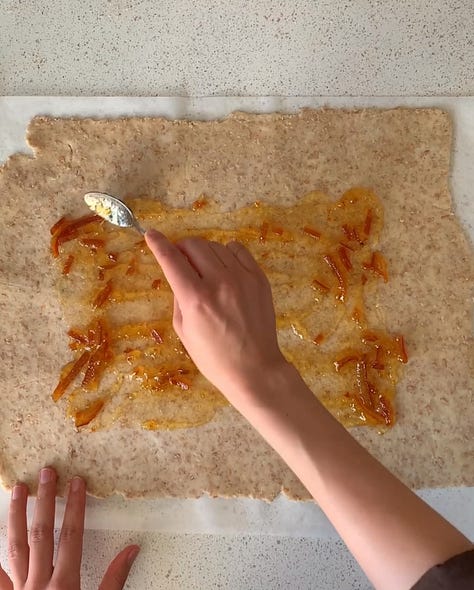
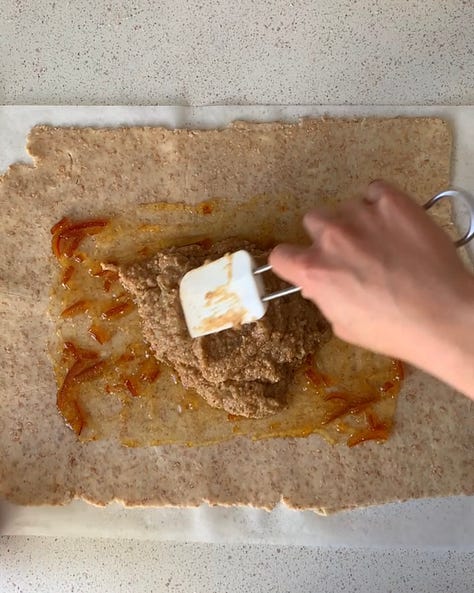
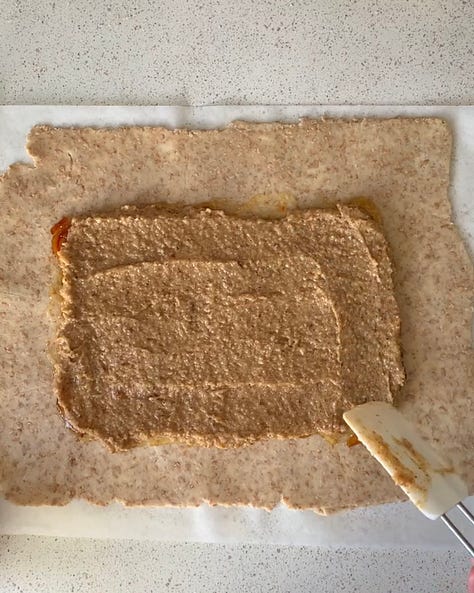
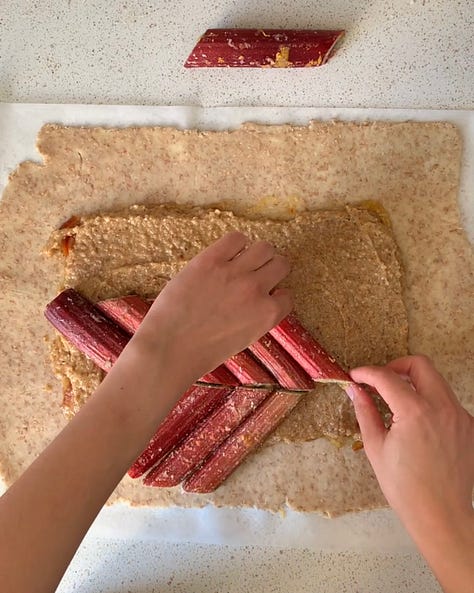
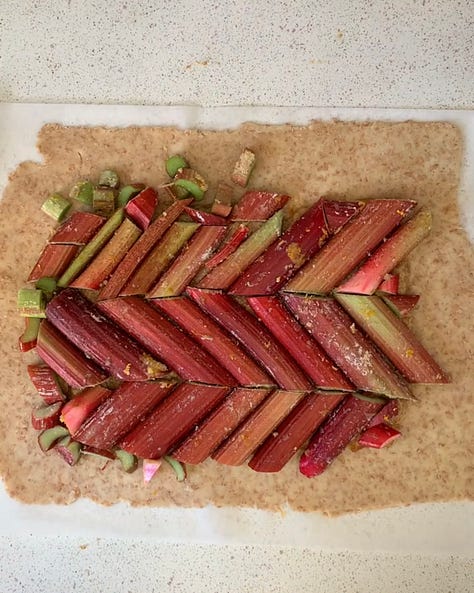
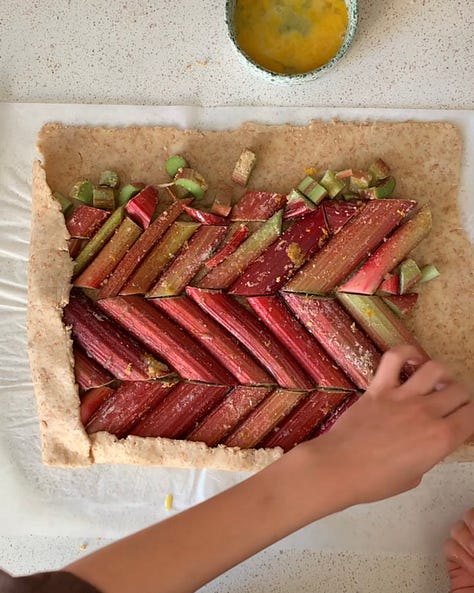

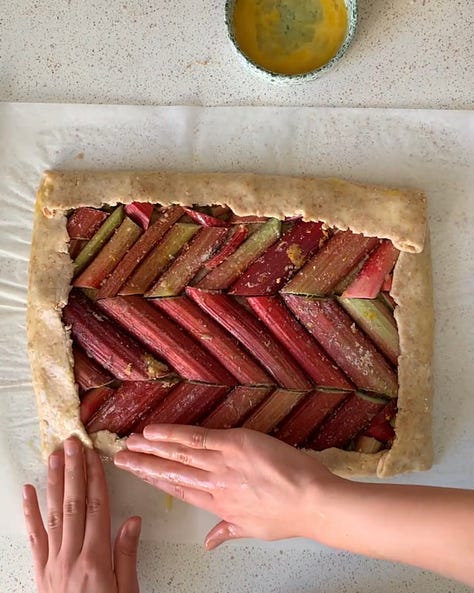
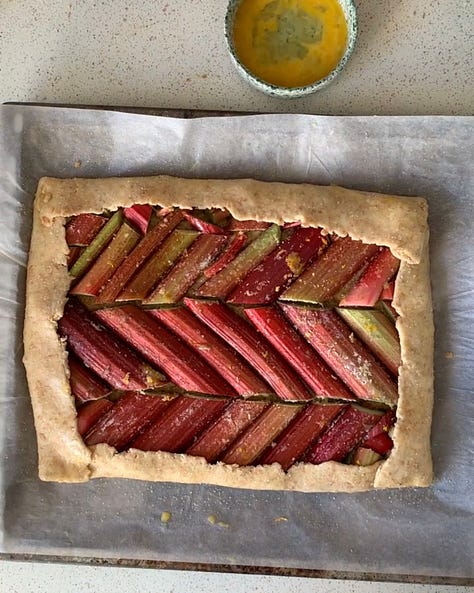
Bake for 30 minutes, or until the crust is golden and the rhubarb is soft enough to be easily pierced with the tip of a sharp knife.
Transfer to a rack to cool.
Enjoy warm or at room temperature, as is, or paired with a cool scoop of vanilla ice cream, a generous pour of hot or cold custard, or a soft swoop of whipped cream and/or yogurt.
Pre-sliced portions will freeze very well and the galette can keep for up to three months in the freezer (in fact, the thawing galette is also surprisingly delicious eaten still mostly-frozen, in case you are too impatient to let it come to room temperature all the way).
last, but not least:
the public health corner 🔗
In case you didn’t know, public health is my jam (more on that here, here, and here) — it informs everything I do! And, as always, I like to leave you with a few parting links relating to the topic, as food for thought:
🗒️ ONE ARTICLE
It’s time to stop the great food heist powered by big business. That means taxation, regulation and healthy school meals, The Guardian
📝 ONE PETITION
🎧 ONE PODCAST EPISODE
📘 ONE BOOK
Serving the Public: The Good Food Revolution in Schools, Hospitals and Prisons, by Kevin Morgan
📺 ONE SHOW
Chef’s Table: Legends (Netflix)
p.s. I always have a hard time just picking one of each so, in case you're interested, there's plenty more where that came from!
If you enjoyed this post, please do kindly give it a 💛 — it really helps make it more visible so others can find it too.
That's all from me this month. See you in the next newsletter!







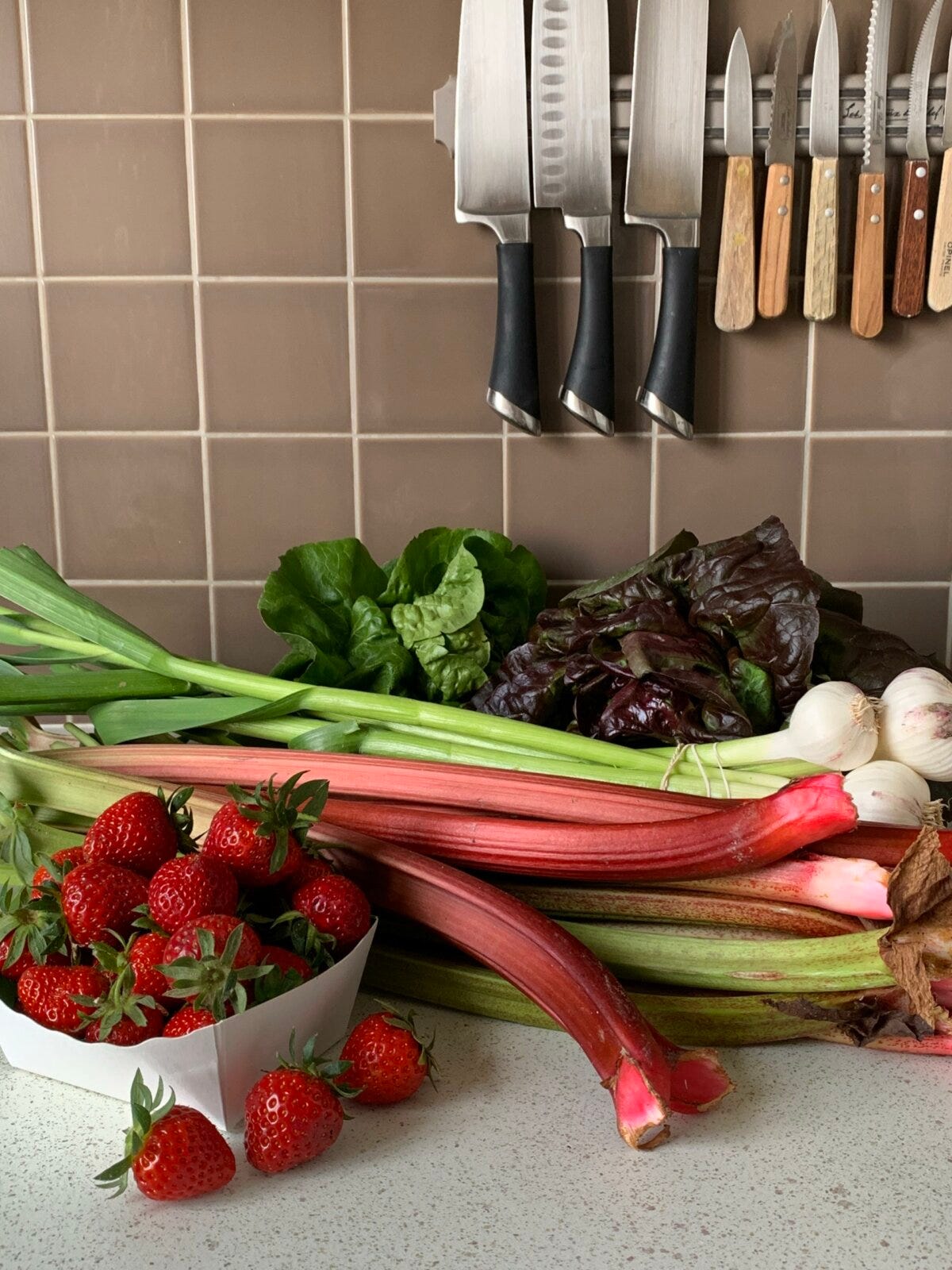
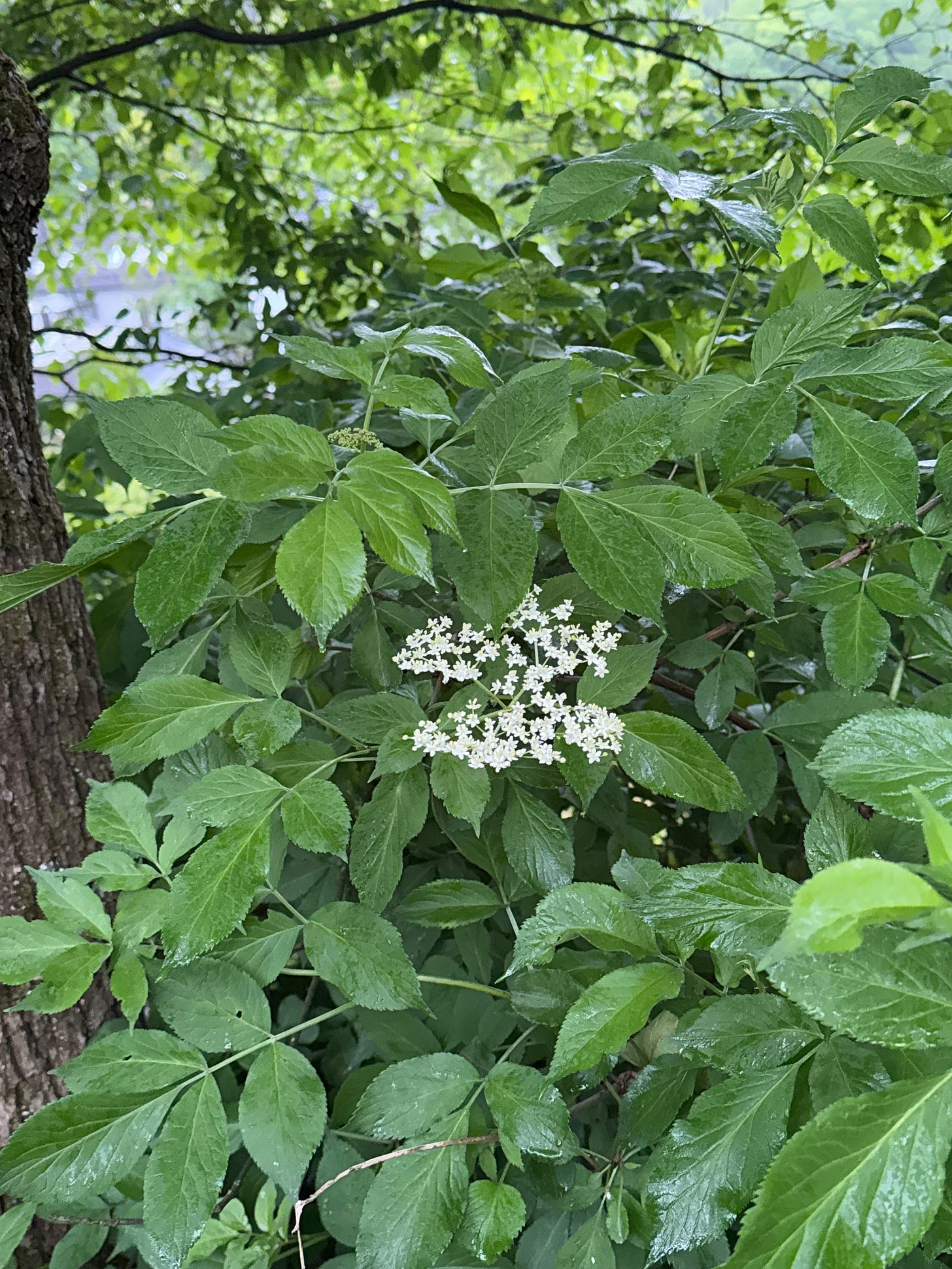
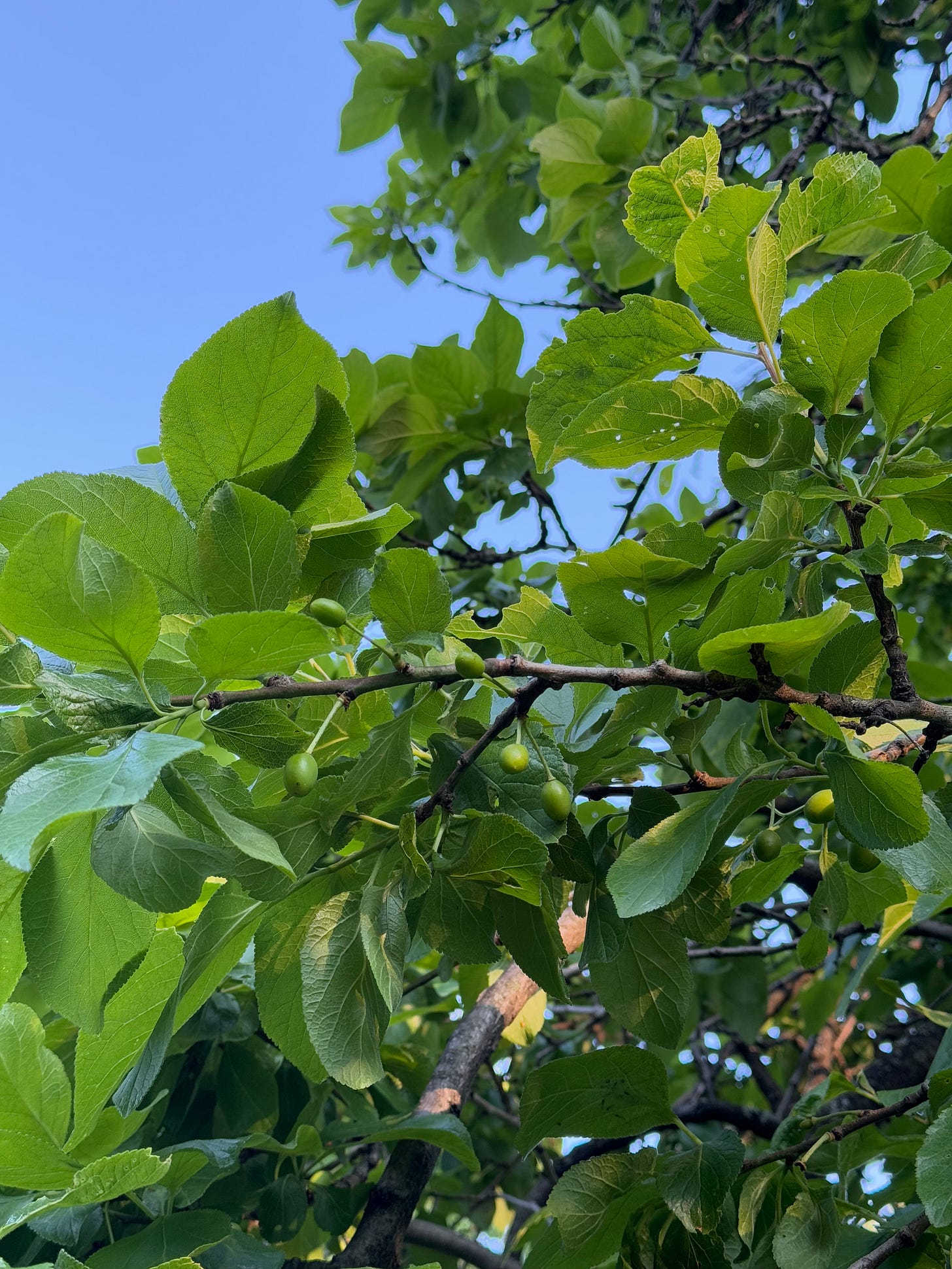
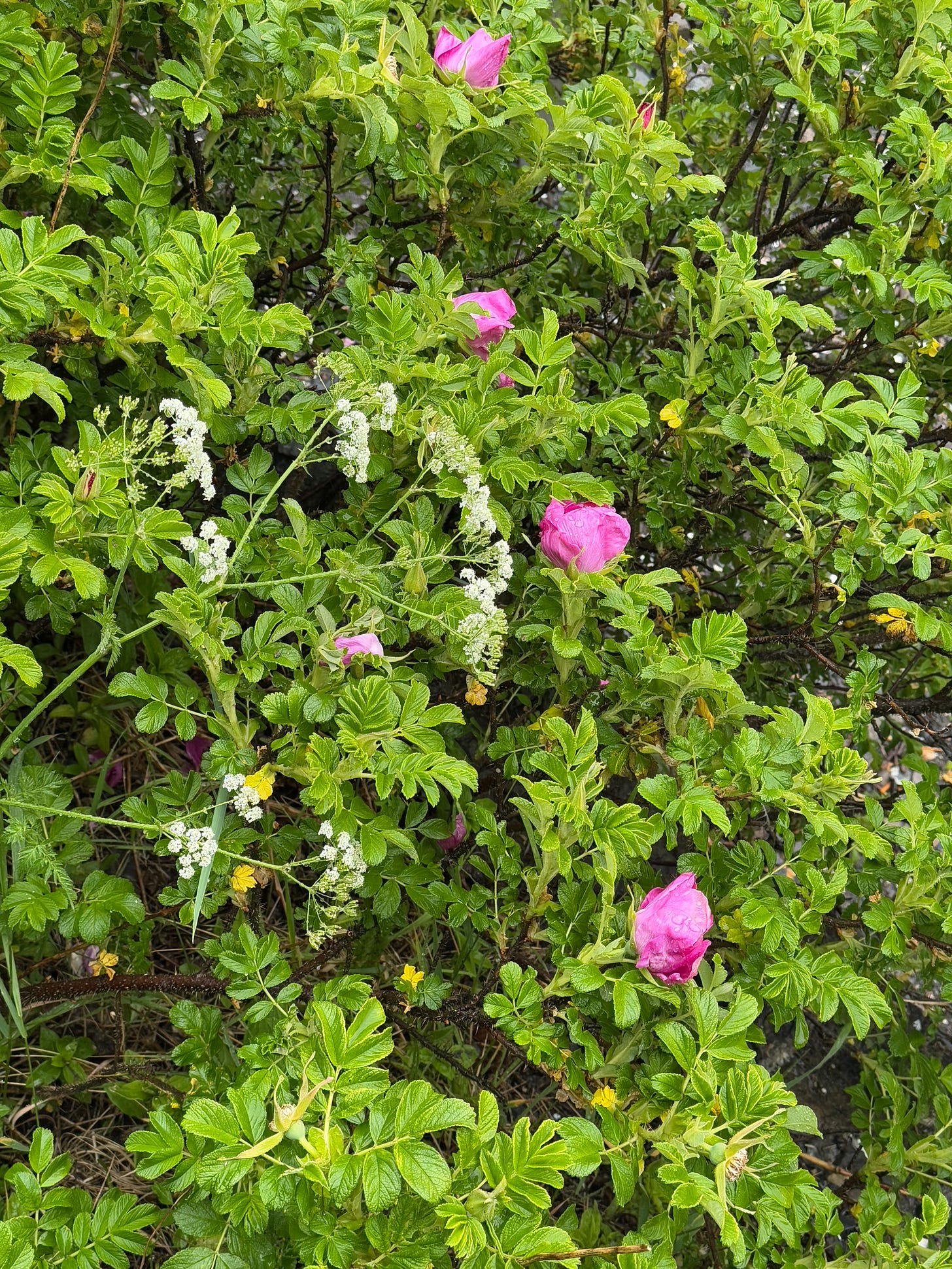
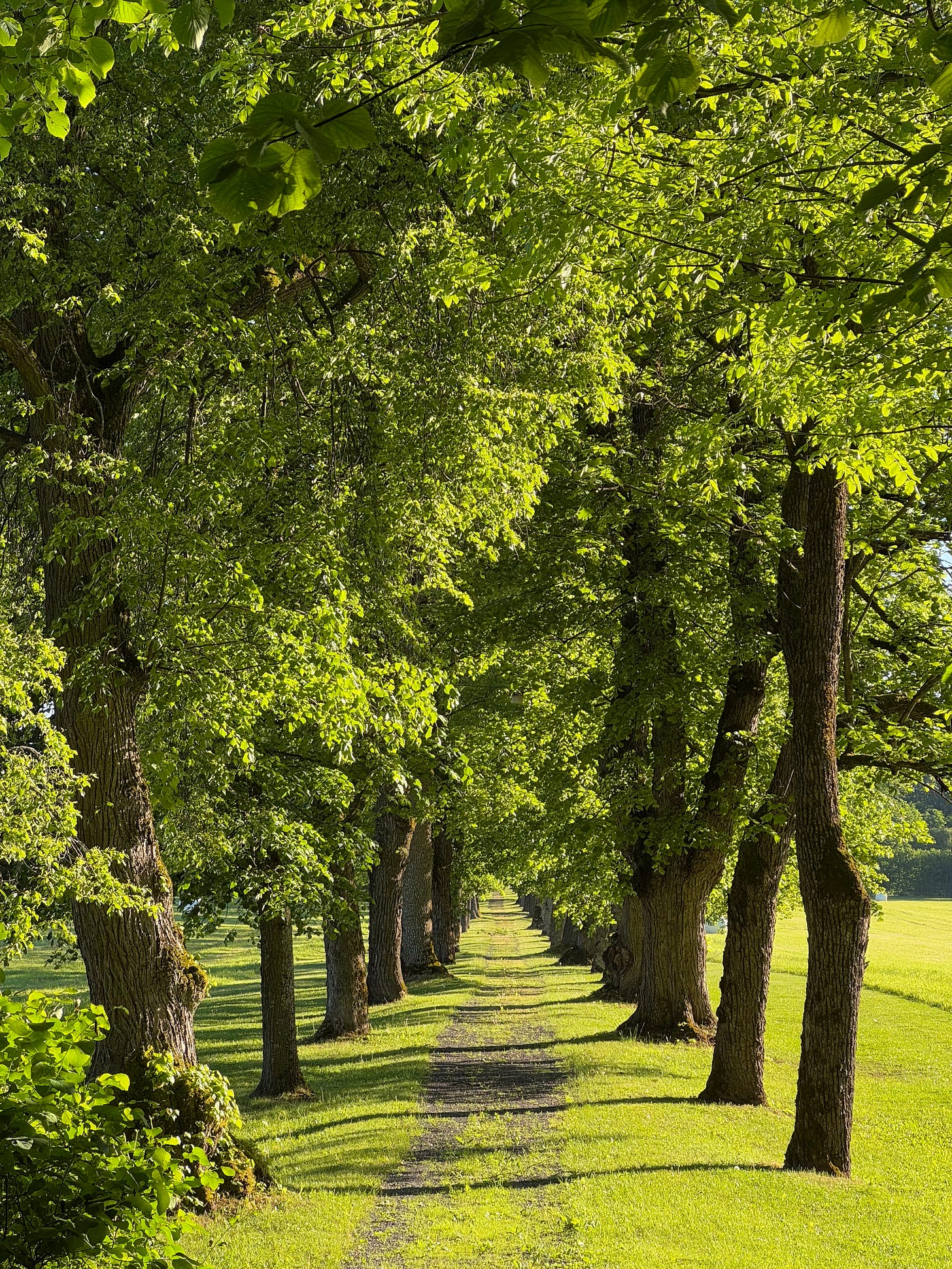
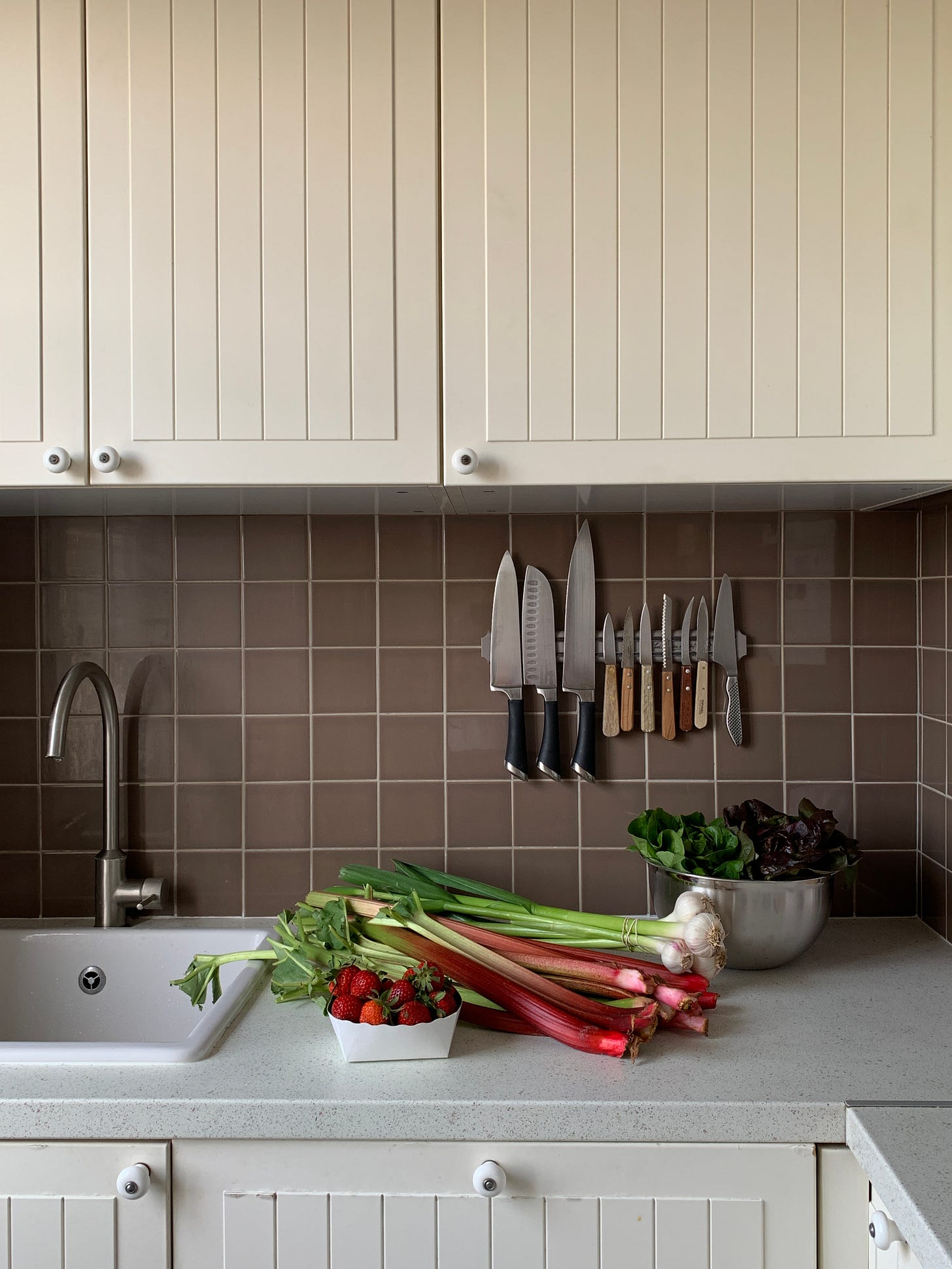
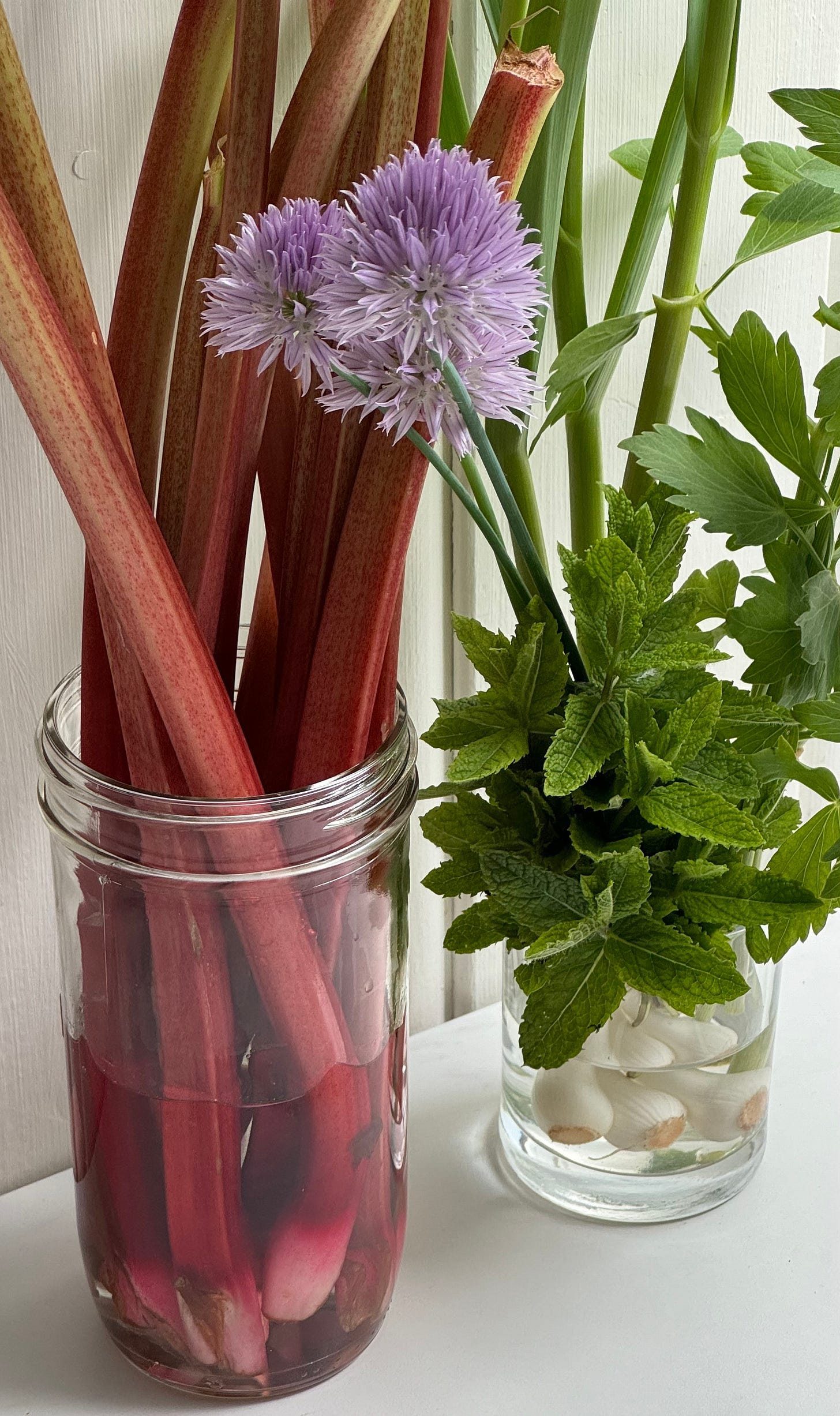
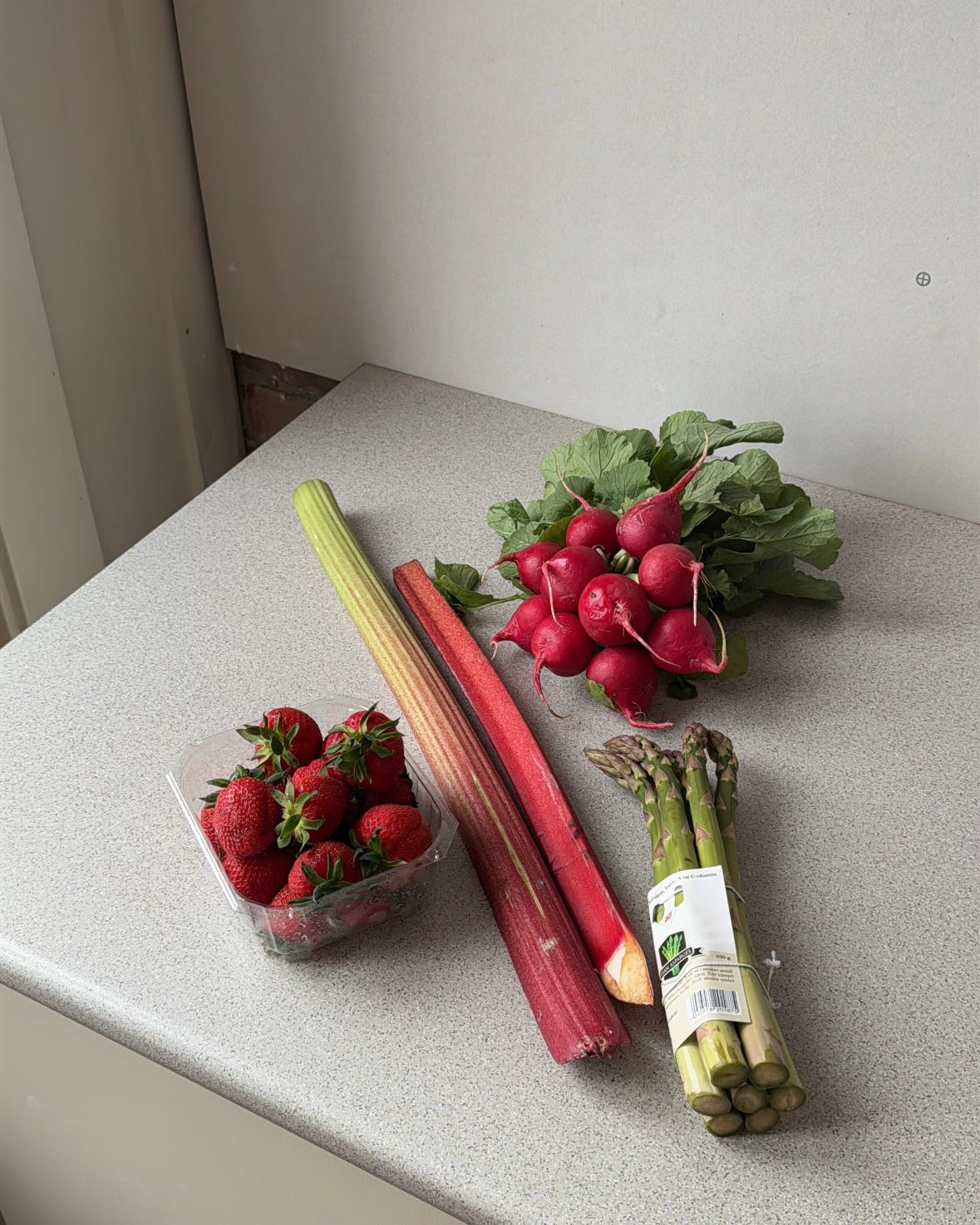
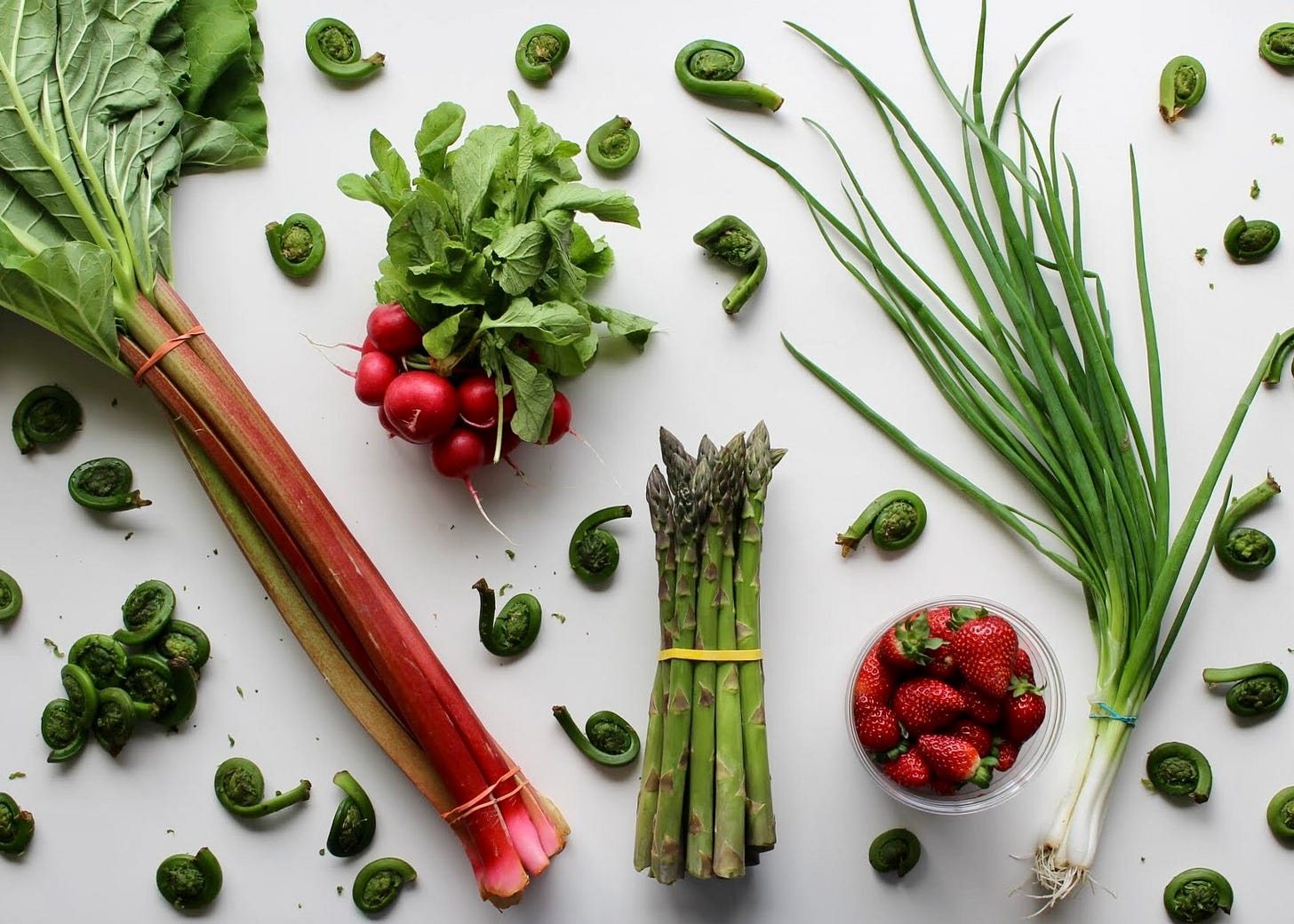

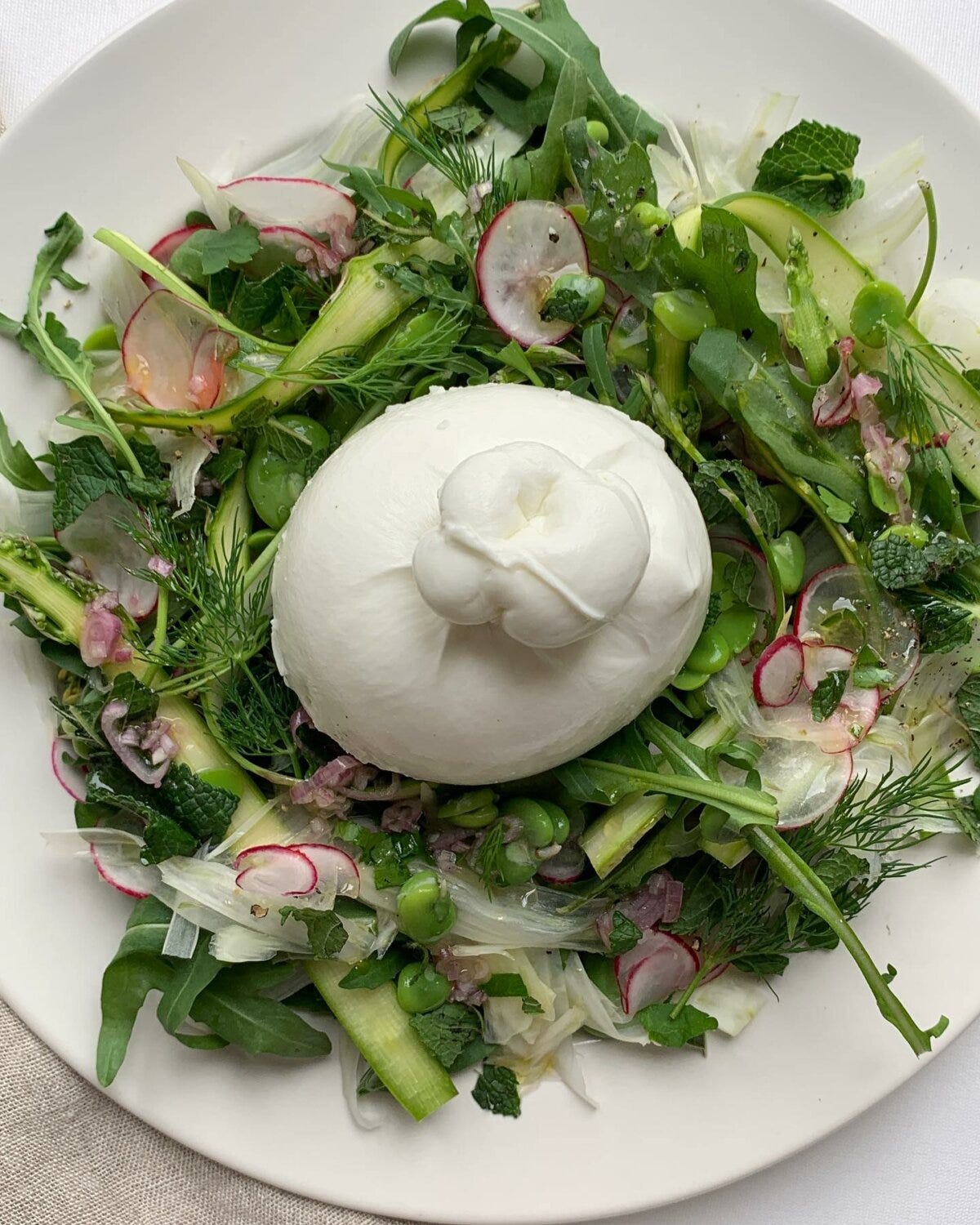

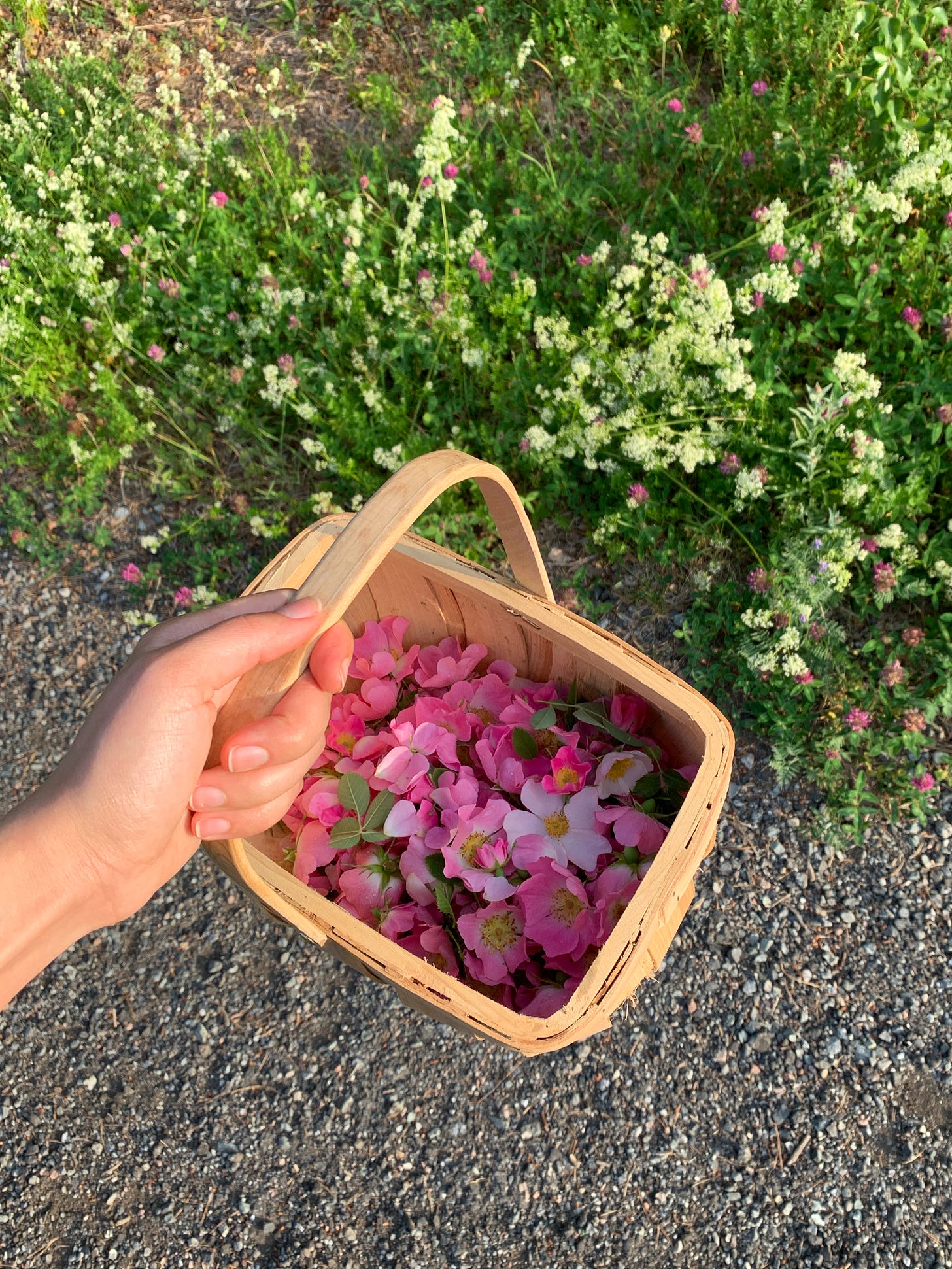
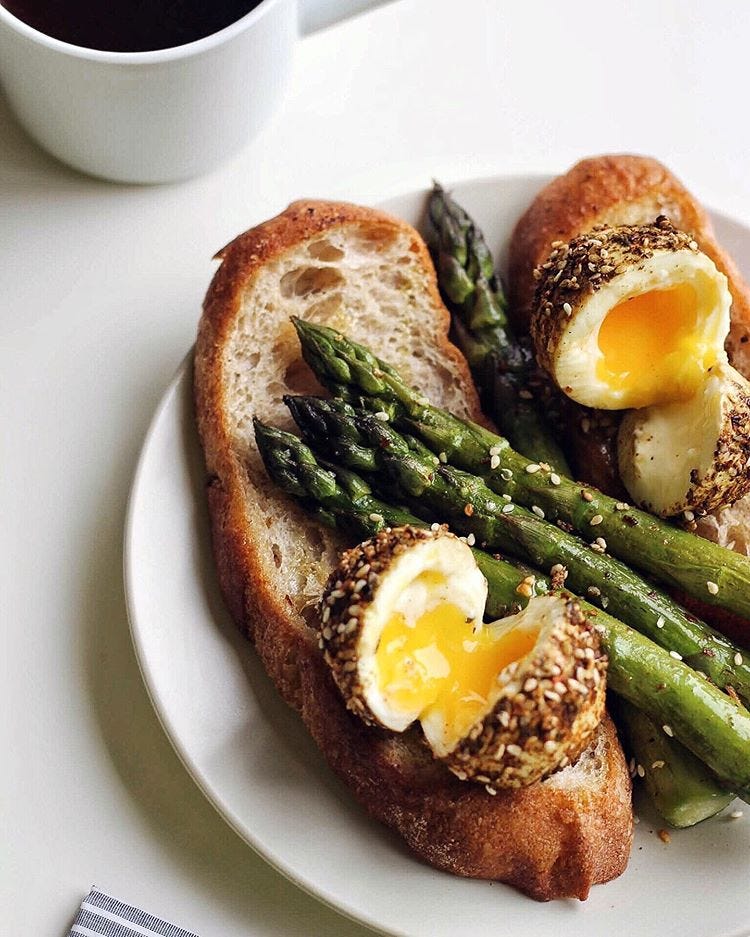
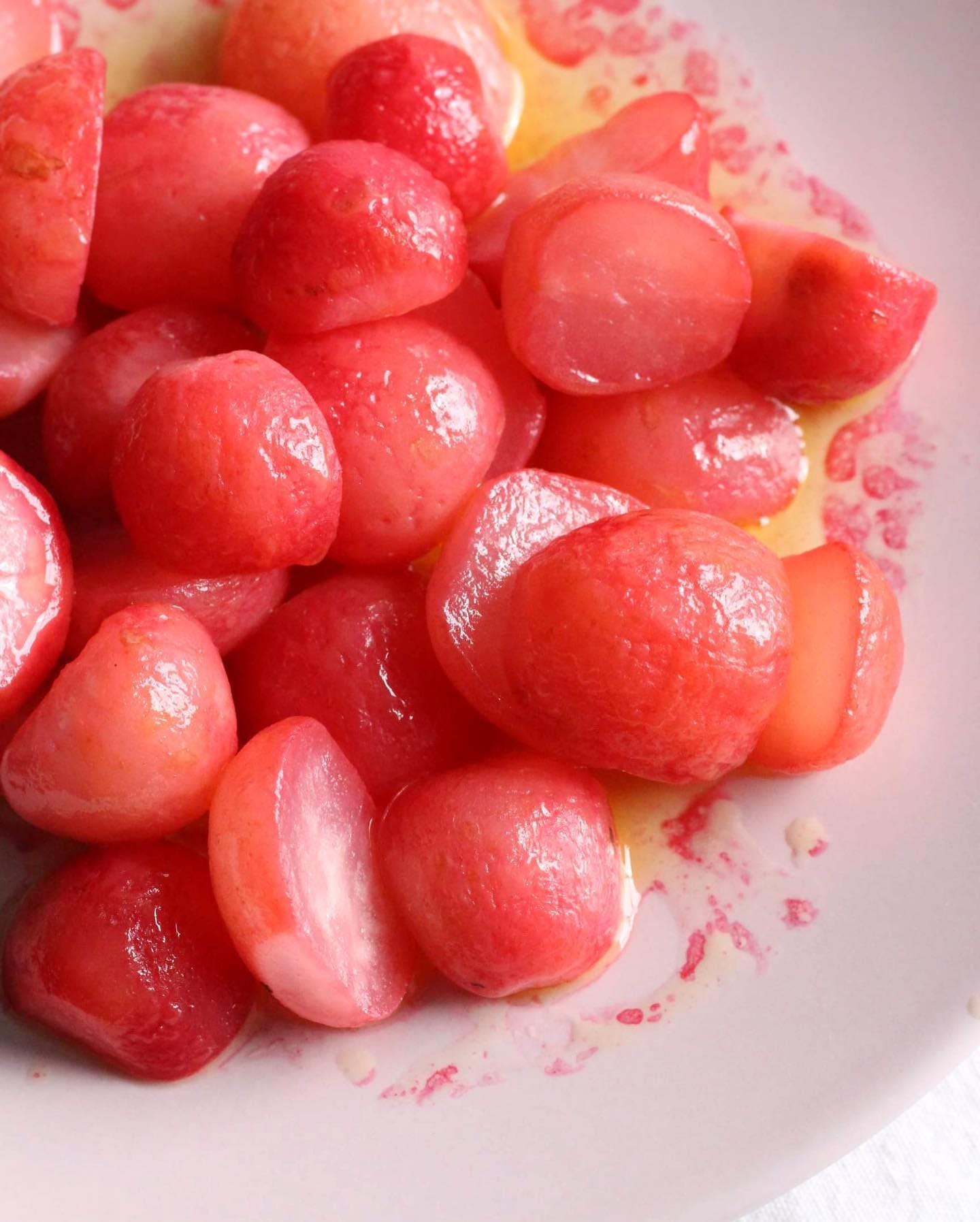
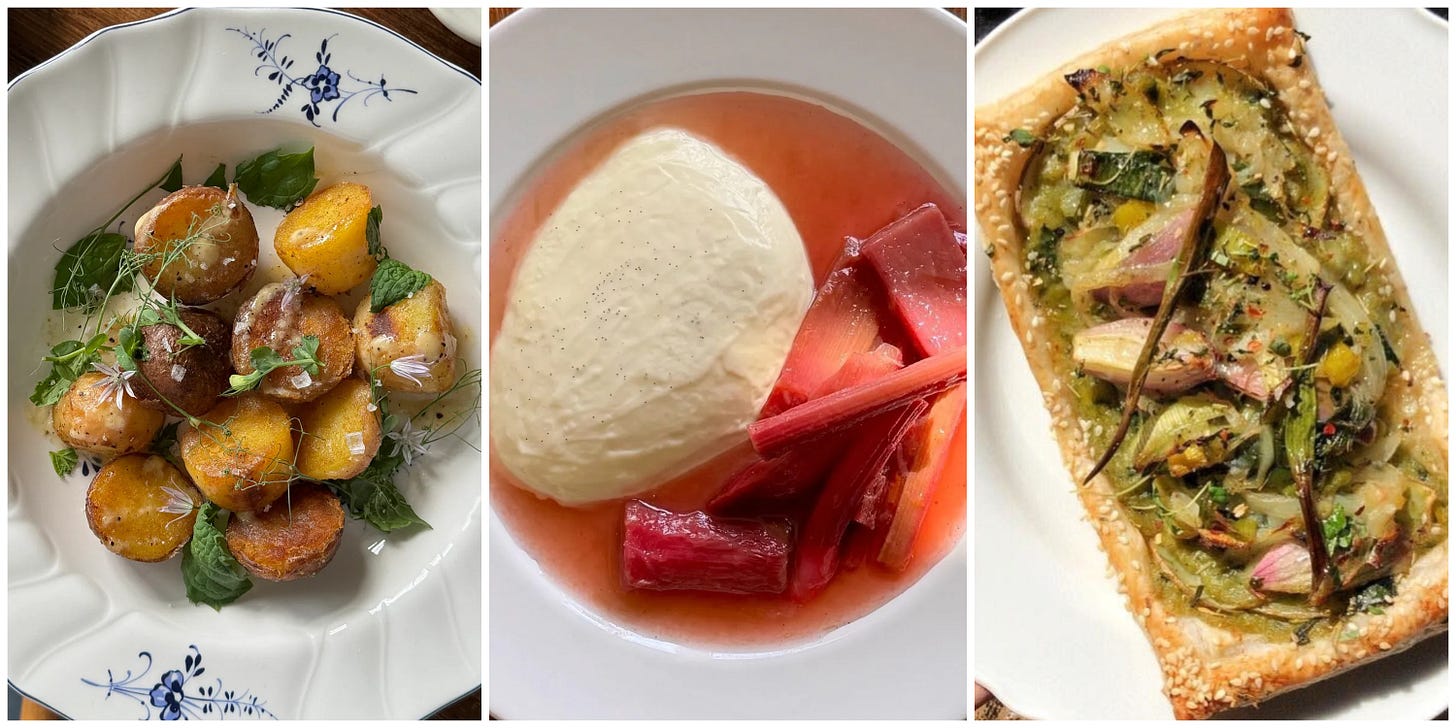
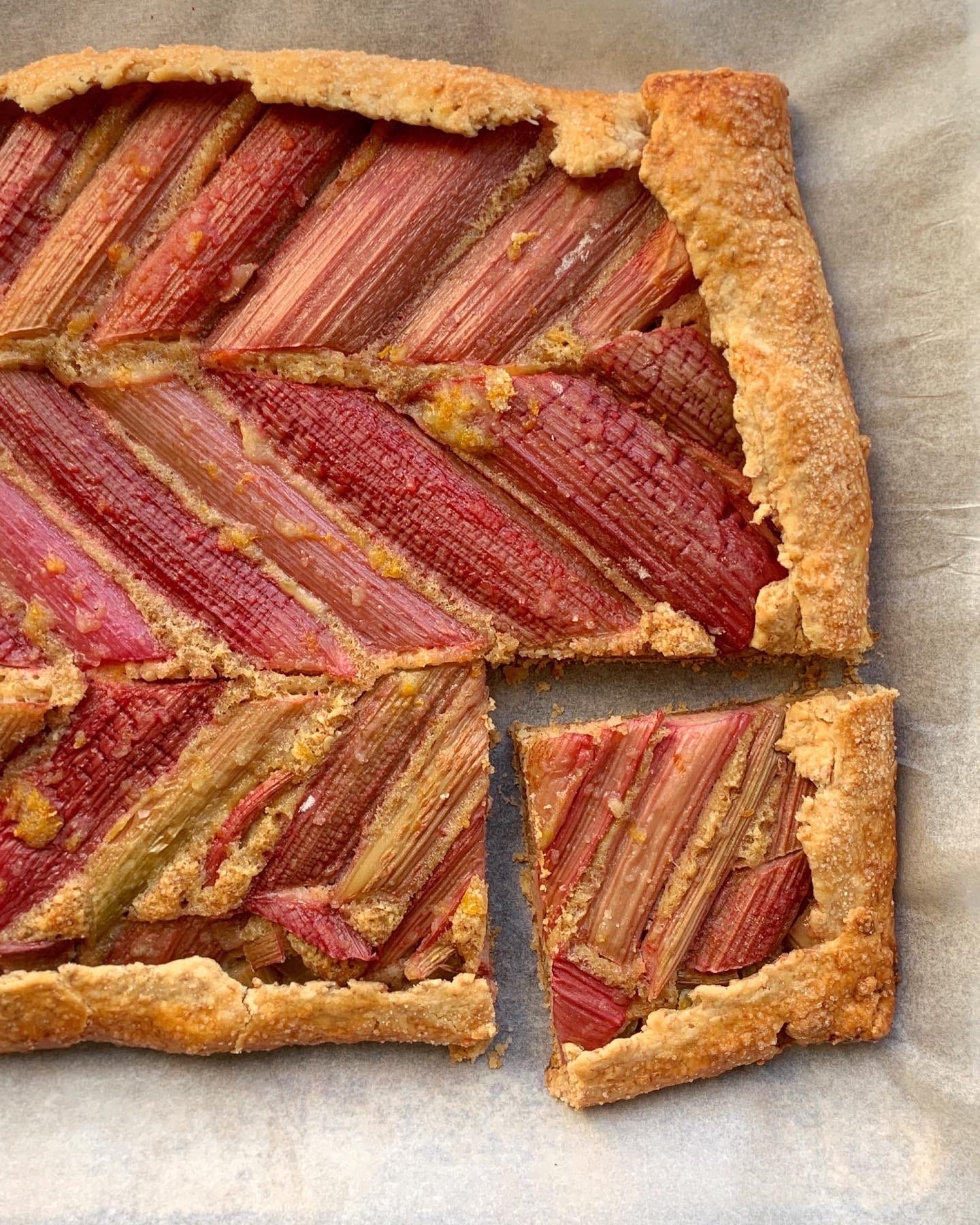
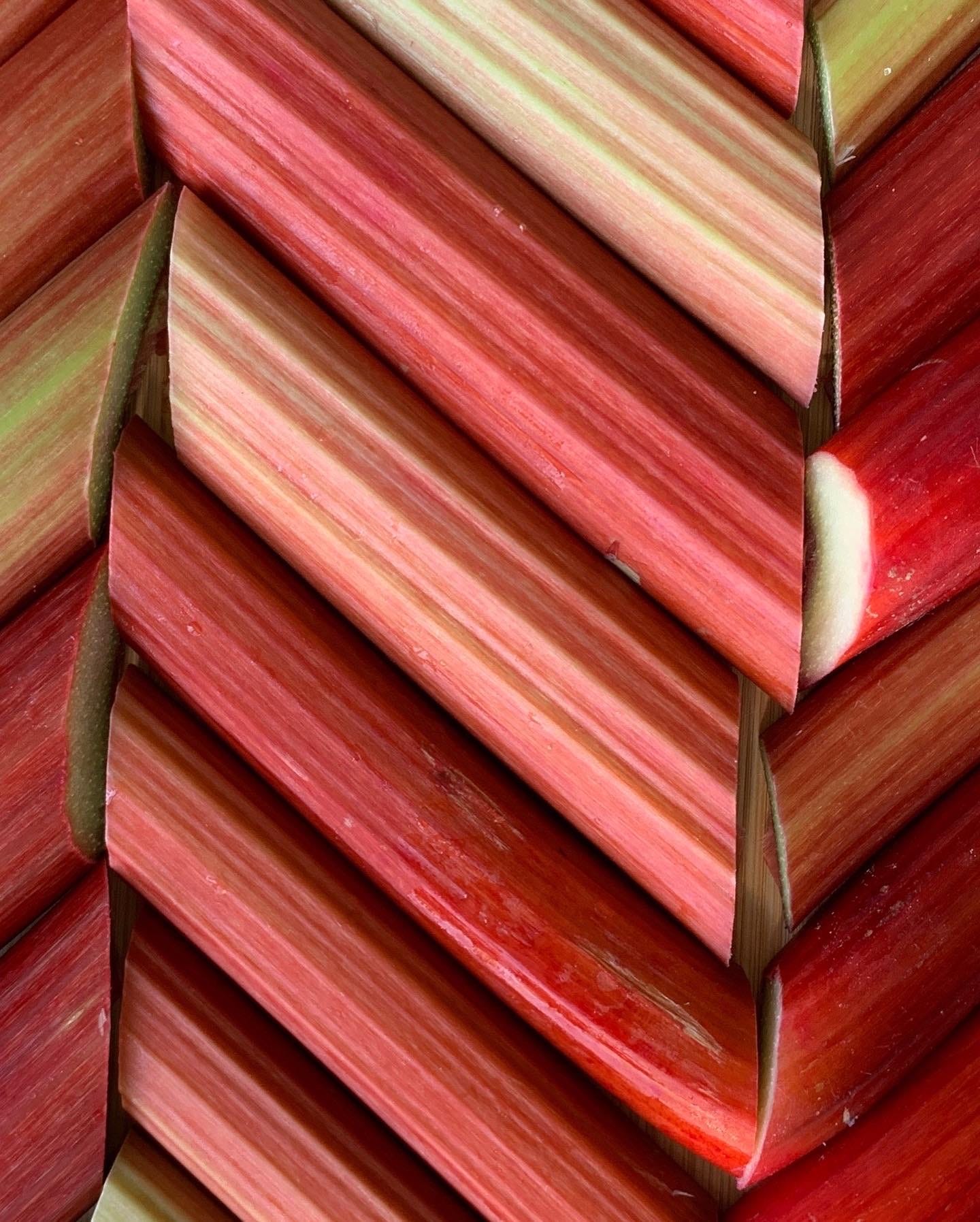
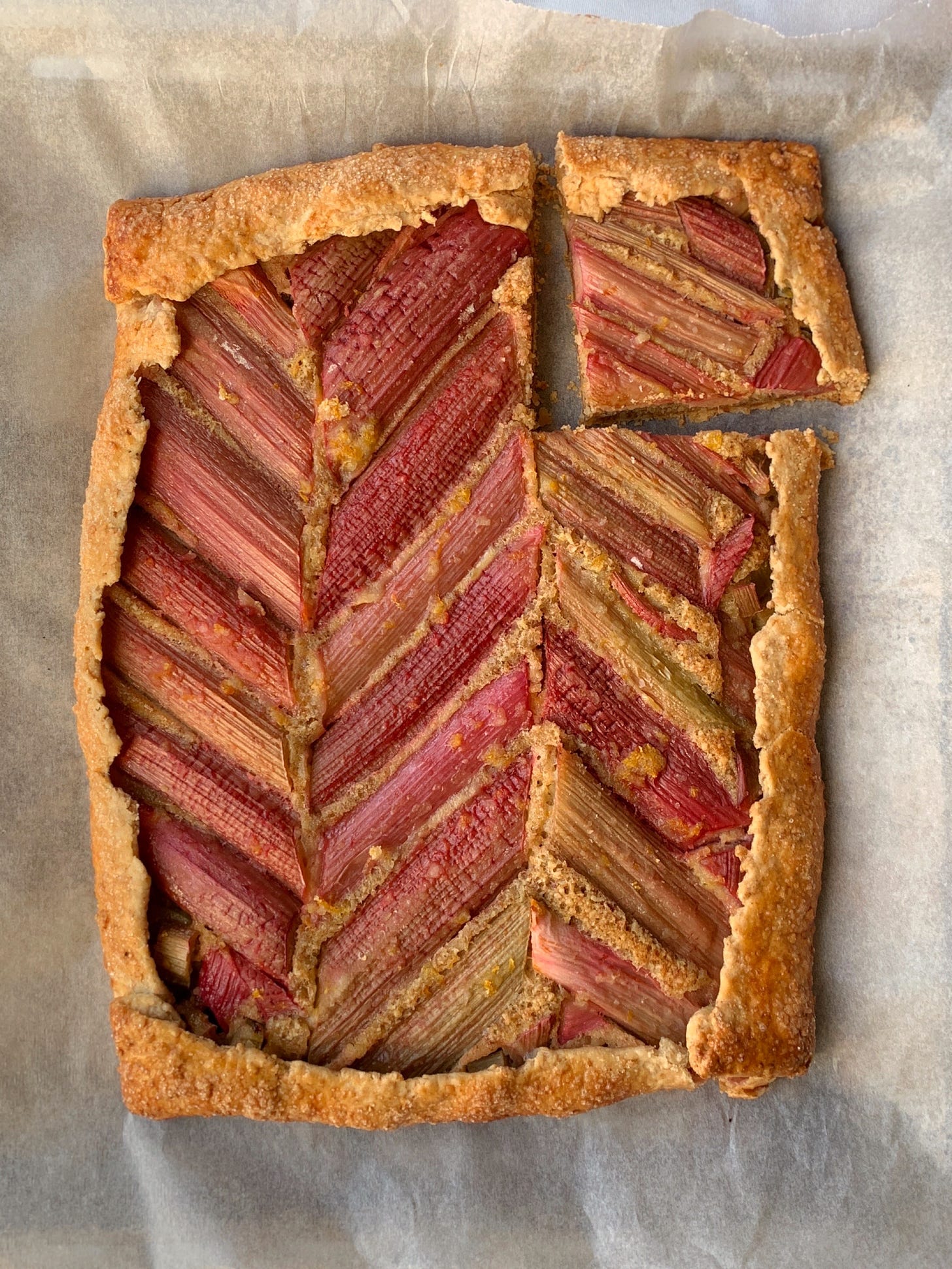



Wow, what a beautifully thorough examples of Spring/early summer bounty! Thanks for sharing